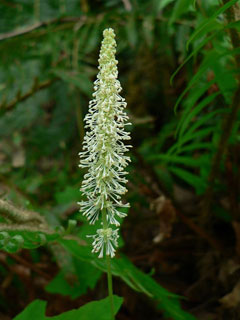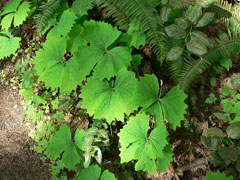 |
|
http://en.wikipedia.org/wiki/User_talk:Wsiegmund |
 |
| http://en.wikipedia.org/wiki/User_talk:Wsiegmund |
Translate this page:
Summary
Physical Characteristics

 Achlys triphylla is a PERENNIAL growing to 0.4 m (1ft 4in). It is in flower from April to July. The species is hermaphrodite (has both male and female organs) and is pollinated by Wind.
Achlys triphylla is a PERENNIAL growing to 0.4 m (1ft 4in). It is in flower from April to July. The species is hermaphrodite (has both male and female organs) and is pollinated by Wind.
Suitable for: light (sandy), medium (loamy) and heavy (clay) soils. Suitable pH: mildly acid, neutral and basic (mildly alkaline) soils. It can grow in semi-shade (light woodland). It prefers moist soil.
UK Hardiness Map
US Hardiness Map
Synonyms
Plant Habitats
Woodland Garden Dappled Shade; Shady Edge;
Edible Uses
References More on Edible Uses
Medicinal Uses
Plants For A Future can not take any responsibility for any adverse effects from the use of plants. Always seek advice from a professional before using a plant medicinally.
Emetic Ophthalmic TB
The plant was used by native North Americans to treat anumber of health problems, though it is little used in modern herbalism[257, 270]. An infusion of the leaves was used in the treatment of tuberculosis and as an emetic[257, 270]. An infusion of the dry shredded roots was used to treat cataracts[257].
References More on Medicinal Uses
The Bookshop: Edible Plant Books
Our Latest books on Perennial Plants For Food Forests and Permaculture Gardens in paperback or digital formats.

Edible Tropical Plants
Food Forest Plants for Hotter Conditions: 250+ Plants For Tropical Food Forests & Permaculture Gardens.
More

Edible Temperate Plants
Plants for Your Food Forest: 500 Plants for Temperate Food Forests & Permaculture Gardens.
More

More Books
PFAF have eight books available in paperback and digital formats. Browse the shop for more information.
Shop Now
Other Uses
Hair Repellent
The leaves have been dried and hung in houses to repel flies and mosquitoes[257]. A decoction of the plant has been used as a furniture and floor wash to get rid of lice, bedbugs and other household pests[257]. An infusion of the leaves has been used as a hair wash[257].
Special Uses
References More on Other Uses
Cultivation details
A woodland plant, it requires a position in semi-shade and a humus-rich soil[280].
References Carbon Farming Information and Carbon Sequestration Information
Temperature Converter
Type a value in the Celsius field to convert the value to Fahrenheit:
Fahrenheit:
The PFAF Bookshop
Plants For A Future have a number of books available in paperback and digital form. Book titles include Edible Plants, Edible Perennials, Edible Trees,Edible Shrubs, Woodland Gardening, and Temperate Food Forest Plants. Our new book is Food Forest Plants For Hotter Conditions (Tropical and Sub-Tropical).
Shop Now
Plant Propagation
Seed - we have no information for this species, bu it is probably best sown as soon as it is ripe in a shady part of a cold frame. If stored seed is used, it should be sown as soon as it is received. Germination can be erratic. Prick out the seedlings as soon as they are large enough to handle and grow them on in a shady part of a greenhouse or cold frame for at least their first winter. Plant them out into their permanent positions during autumn or early winter. Division should be possible in early spring or just after flowering.
Other Names
If available other names are mentioned here
Native Range
TEMPERATE ASIA: Korea, Japan (Hokkaidô, Honshu (north)) NORTHERN AMERICA: Canada (British Columbia (southwest)), United States (Oregon (west), Washington (west), California (northwest))
Weed Potential
Right plant wrong place. We are currently updating this section.
Please note that a plant may be invasive in one area but may not in your area so it's worth checking.
Conservation Status
IUCN Red List of Threatened Plants Status :

Growth: S = slow M = medium F = fast. Soil: L = light (sandy) M = medium H = heavy (clay). pH: A = acid N = neutral B = basic (alkaline). Shade: F = full shade S = semi-shade N = no shade. Moisture: D = dry M = Moist We = wet Wa = water.
Now available:
Food Forest Plants for Mediterranean Conditions
350+ Perennial Plants For Mediterranean and Drier Food Forests and Permaculture Gardens.
[Paperback and eBook]
This is the third in Plants For A Future's series of plant guides for food forests tailored to
specific climate zones. Following volumes on temperate and tropical ecosystems, this book focuses
on species suited to Mediterranean conditions—regions with hot, dry summers and cool, wet winters,
often facing the added challenge of climate change.
Read More
Expert comment
Author
(Sm.)DC.
Botanical References
270280
Links / References
For a list of references used on this page please go here
Readers comment